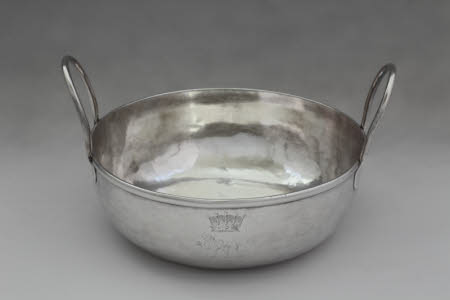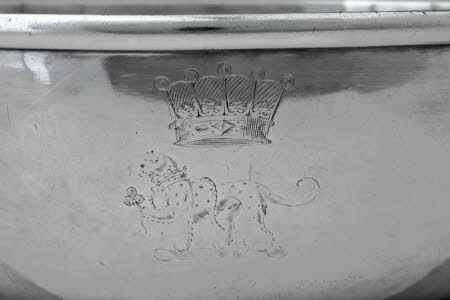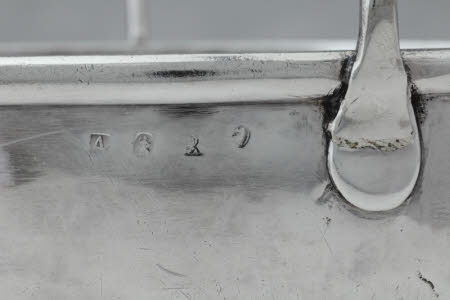Preserving basin
Simon Pantin (1680-1728)
Category
Silver
Date
1716 - 1717
Materials
Silver
Measurements
14 cm (Height); 19.5 cm (Height); 29.7 cm (Diameter); 34.6 cm (Diameter)
Place of origin
London
Order this imageCollection
Ickworth, Suffolk
NT 852083
Summary
Britannia silver preserving basin by Simon Pantin, London, 1716/17. The simple, circular basin, raised into a deep, steep-sided bowl with an applied lip moulding, has two thick wires curved to form handles which are flattened at the ends and soldered to the body. Heraldry: On one side of the basin has been engraved, possibly c.1727, the Hervey crest beneath an earl’s coronet.
Full description
This piece bears the date-letter for 1716 and on 29 August that year Lord Bristol paid his banker-goldsmith James Chambers ‘for a silver stew-pan’. As a consequence, the two were generally conflated in the twentieth century. The weight of the stew-pan at 67oz 14dwt is, however, so far apart from that scratched on the surviving piece – 57oz 18dwt – that this cannot be the case. Wear and tear would not have removed so much silver and there is no evidence of alteration or even the loss of a lid, convention including such associated parts in the scratchweight. Stew pans seem in fact to have been large saucepans with single, turned-wood handles as was that supplied to the Duke of Devonshire by George Wickes in 1738.[1] It would also appear, from the well-recorded equivalent of 1728 by Isaac Liger at Dunham Massey in Cheshire (NT 936026), that this sort of bowl-like, two-handled vessel was known as a preserving basin, which the Ickworth piece was recorded as in the 1811 inventory.[2] This is corroborated by Sir Robert Walpole’s ‘Preserving Pann’ and Sir Henry Harpur’s ‘preserving dish’, supplied by George Wickes in 1738 and 1743 respectively, as neither included a wooden handle. They weighed 40oz 9dwt and 28oz and were charged at 6s 5d per ounce and 6s 4d.[3] There is no other specific entry in Lord Bristol’s accounts that could relate to the basin so it is likely to have been another of his purchases of second-hand plate, perhaps being amongst the items from the estate of the Countess’s aunt, Elizabeth Felton, Lady Howard of Effingham, paid for on 23 April 1727. Silver was used in the kitchen and still room because of its excellent conductivity, which assisted sensitive cooking, and for use with acidic ingredients where copper, brass and iron may have been vulnerable and have risked tainting or even, in the case of copper, poisoning. Ingredients high in acid, notably fruit, can result in the formation of copper acetates, or verdigris, which when consumed is potentially fatal. This danger was well understood in the eighteenth century and an anonymous pamphleteer writing in 1755 noted the particular risk associated with the preparation in untinned copper of ‘preserved fruits and sweetmeats of every kind. Of these sweetmeats children of almost every rank and age, even infants, eat in abundance; but people of quality most of all, as they scarce ever dine without a desert.’[4] Tinning or silvering could be applied but that was not permanent or fail-safe and solid silver was the ideal for those who could afford it.[5] The sort of concoction for which a silver cooking vessel might have been used is indicated in the published and manuscript recipe books of the period. Hannah Glasse in The art of cookery made plain and easy of 1747 recommended silver in preparing, amongst other things, a dish called ‘Lemon Cream’, and for simply melting butter,[6] and numerous of Lady Mary Booth of Dunham Massey’s recipes, recorded in 1730, are likely to have employed the surviving basin there. For the preserving of ‘Goosberries in Jelly before they are ripe’, requiring countless rounds of boiling and resting and aiming at a jelly ‘as clear as Rock water’, Lady Mary unconditionally specified a ‘Silver Bason’.[7] James Rothwell, Decorative Arts CuratorDecember 2020 [Adapted from James Rothwell, Silver for Entertaining: The Ickworth Collection, London 2017, cat. 10, p. 78].Notes: [1] National Art Library, V & A (NAL, Garrard Ledgers, VAM 1 1735–40, f. 162. [2] Christie’s 12 June 2007, lot 55. This item was purchased by the National Trust subsequent to the publication of Country House Silver from Dunham Massey (2006). [3] NAL (see note 1), VAM 1 1735–40, f. 137 and VAM 2 1740–8, f. 73. [4] Anonymous, Serious reflections on the manifold dangers attending the use of copper vessels … , London, 1755, p. 22 [5] Charlotte Mason, The Lady's Assistant, London, 1787, pp. 120 and 475-6. [6] Hannah Glasse , The art of cookery made plain and easy, London, 1747, pp. 5 and 281. Jonathan Swift recommended the same, to avoid tainting the butter – Directions to servants, London, 1745, p. 42. [7] Lady Mary Booth, ''Receits transcribed from a book of the Right Honourable Earl of Warrington's … ', 1730, pp. 143-5. I am grateful to Nicola Whyton for transcribing these and other entries for me. National Trust, Dunham Massey.
Provenance
Possibly acquired by Elizabeth Felton, Lady Howard of Effingham (d. 1726); 1st Earl of Bristol; by descent to the 4th Marquess; accepted by the Treasury in lieu of death duties in 1956 and transferred to the National Trust.
Credit line
Ickworth, the Bristol Collection (National Trust)
Marks and inscriptions
Outer side, beneath lip: Hallmarks: Fully marked beneath lip with date letter ‘A’, Britannia, maker’s mark ‘PA’ beneath tree (Arthur Grimwade, London Goldsmiths 1697-1837, 1990, no. 2124), lion’s head erased. Underside: Scratchweight: ‘57 18 [/] II’
Makers and roles
Simon Pantin (1680-1728), goldsmith


